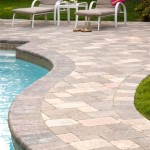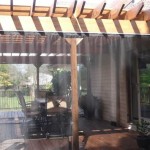How To Build A Small Patio For Your Grill
Creating a dedicated space for your grill can significantly enhance outdoor cooking experiences. A small patio provides a stable, safe, and aesthetically pleasing area for grilling, separate from other areas of the yard. This article details the process of building a small patio specifically designed for a grill, covering planning, material selection, construction, and necessary safety considerations.
Planning and Design Considerations
Before commencing any construction, meticulous planning is crucial. This stage involves assessing the available space, determining patio dimensions, selecting appropriate materials, and considering drainage and safety aspects.
First, evaluate the desired location for the grill patio. Consider proximity to the house, prevailing wind direction, and the presence of any nearby structures or landscaping. Ideally, the patio should be located near a back door for easy access to the kitchen, yet far enough from the house to minimize the risk of smoke or heat damage. The prevailing wind direction should be taken into account to direct smoke away from the house and any seating areas.
Next, determine the optimal size and shape of the patio. The size should be adequate to comfortably accommodate the grill, a small work surface, and enough space for the user to move around safely. A general recommendation is to allocate a minimum of 6 feet by 6 feet for a small grill patio. The shape can be square, rectangular, or even circular, depending on the available space and aesthetic preferences. Mark the proposed dimensions on the ground using stakes and string to visualize the layout and ensure it meets the required needs.
Material selection is a critical aspect of the planning phase. Common materials for small patios include pavers, concrete, gravel, and flagstone. Pavers offer a wide range of colors, shapes, and textures, providing design flexibility. Concrete is a durable and relatively inexpensive option, suitable for creating a simple, functional patio. Gravel is a low-cost and easy-to-install option, often used for informal grilling areas. Flagstone offers a natural, rustic appearance but can be more challenging to install due to its irregular shapes. The chosen material should be resistant to heat, weather, and foot traffic, ensuring long-term durability and stability.
Drainage is essential to prevent water accumulation and potential damage to the patio and surrounding landscape. Ensure the patio has a slight slope away from the house to facilitate water runoff. The gradient should be subtle, approximately ¼ inch per foot, to avoid creating an uneven surface. Consider the existing drainage patterns in the yard and integrate the patio design to complement these patterns. Installing a French drain or a similar drainage system may be necessary in areas with poor drainage.
Safety considerations are paramount throughout the planning and construction process. The patio should be located away from flammable materials such as dry leaves, mulch, or wooden structures. Ensure there is adequate clearance around the grill to prevent accidental contact with combustible surfaces. A fire extinguisher should be readily accessible nearby. Consider incorporating a heat-resistant barrier between the grill and any adjacent wooden structures, such as a fence or deck railing.
Construction Process: From Excavation to Surface Installation
The construction process involves several key steps, including excavation, base preparation, material installation, and finishing touches. Each step must be executed carefully to ensure a stable, durable, and aesthetically pleasing patio.
Excavation is the first step in preparing the site. Remove the existing sod and topsoil to a depth of approximately 6 to 8 inches. This depth allows for a sufficient base of compacted gravel and bedding sand. Use a shovel and wheelbarrow to remove the excavated material, ensuring the area is level and free of debris. Check the grade of the excavation to ensure proper drainage. Using a level and a measuring stick to check for consistency is recommended.
Base preparation is crucial for providing a stable and level foundation for the patio. A well-prepared base prevents sinking, shifting, and cracking over time. Spread a layer of compacted gravel, approximately 4 to 6 inches thick, over the excavated area. Use a plate compactor or a hand tamper to compact the gravel thoroughly. This step consolidates the gravel, creating a solid base. Ensure the gravel is evenly distributed and compacted to the specified depth.
Following the compacted gravel, a layer of bedding sand is applied. This layer provides a smooth and level surface for the patio material. Spread a layer of bedding sand, approximately 1 to 2 inches thick, over the compacted gravel. Use a screed board or a similar tool to level the sand, creating a uniform surface. The sand should be moist but not saturated. Avoid walking on the leveled sand to prevent disturbing the surface. Accurate leveling of this layer is essential for achieving a flat and even patio surface.
Material installation varies depending on the chosen patio material. For pavers or flagstone, carefully place each piece onto the bedding sand, ensuring they are level and evenly spaced. Use a rubber mallet to gently tap each piece into place, ensuring it is firmly seated in the sand. Maintain consistent spacing between the pavers or flagstones, typically ¼ to ½ inch, to allow for joint filling. Use spacers to ensure uniformity in the gaps. For concrete, pour the concrete mix into the prepared area, ensuring it is evenly distributed. Use a concrete trowel to smooth the surface and create a level finish. For gravel, spread the gravel evenly over the prepared area, ensuring it is compacted and level. Use a rake or shovel to distribute the gravel and a hand tamper to compact it.
Finishing touches enhance the appearance and stability of the patio. For pavers or flagstone, fill the joints between the pieces with polymeric sand or jointing compound. This material stabilizes the pavers and prevents weed growth. Sweep the patio surface clean after applying the jointing material. For concrete, consider adding a sealant to protect the surface from staining and weathering. For gravel, add edging around the patio to contain the gravel and prevent it from spreading. Edging can be made from wood, metal, or plastic. Ensure the edging is securely anchored in the ground.
Essential Tools and Materials
Having the right tools and materials is essential for completing the project efficiently and effectively. This section outlines a comprehensive list of necessary items.
Essential tools encompass those needed for excavation, leveling, cutting, and compacting. A shovel and a wheelbarrow are necessary for removing sod, topsoil, and other excavated materials. A level, measuring tape, and stakes are needed for marking out the patio dimensions and ensuring proper leveling. A plate compactor or hand tamper is crucial for compacting the gravel and bedding sand. A screed board or similar leveling tool is needed for creating a smooth and even surface for the bedding sand. A rubber mallet is useful for setting pavers or flagstones into place. A concrete trowel is necessary for smoothing the concrete surface. A circular saw with a masonry blade is needed for cutting pavers or flagstones to size.
Necessary materials are those needed for constructing the patio foundation and surface. Gravel forms the base of the patio, providing a stable foundation. Bedding sand creates a smooth and level surface for the patio material. Pavers, concrete, gravel, or flagstone are the materials used to construct the patio surface. Polymeric sand or jointing compound fills the joints between pavers or flagstones, stabilizing them and preventing weed growth. Concrete sealant protects the concrete surface from staining and weathering. Edging material, such as wood, metal, or plastic, contains the gravel and prevents it from spreading. Safety glasses, gloves, and a dust mask are essential for protecting oneself during construction.
Safety equipment is crucial for protecting against potential hazards during the construction process. Safety glasses protect the eyes from dust, debris, and flying particles. Gloves protect the hands from cuts, abrasions, and exposure to chemicals. A dust mask protects the lungs from inhaling dust and other airborne particles. Hearing protection, such as earplugs or earmuffs, may be necessary when using power tools. Sturdy work boots provide foot and ankle support and protect against potential injuries. A first-aid kit should be readily available in case of minor injuries.
Additional considerations include securing necessary permits. Depending on the location and size of the patio, it may be necessary to obtain permits from the local building department. Check with the local authorities to determine the specific requirements for the project. Understanding local codes and regulations ensures compliance and avoids potential legal issues. Moreover, consider weather conditions. Avoid constructing the patio during periods of heavy rain or extreme temperatures. Ideal weather conditions for patio construction are mild and dry. This ensures optimal compaction and setting of materials. Proper planning and execution are important for a successful outcome.

The New Grill Cart Patio Extension Love Renovations

How To Make A Grill Landing Pad 4th House On The Right

How To Make A Grill Landing Pad 4th House On The Right

The New Grill Cart Patio Extension Love Renovations

Building A Floating Deck Grill Station In One Weekend Diy Huntress

Outdoor Grill Station Ideas 10 Ways To Elevate Summer Bbqs Homes Gardens

How To Build A Grill Station One Handy Momma

How We Diyed Our Built In Grill Chris Loves Julia

How To Make A Grill Landing Pad 4th House On The Right

How To Build A Grill Station One Handy Momma
Related Posts








